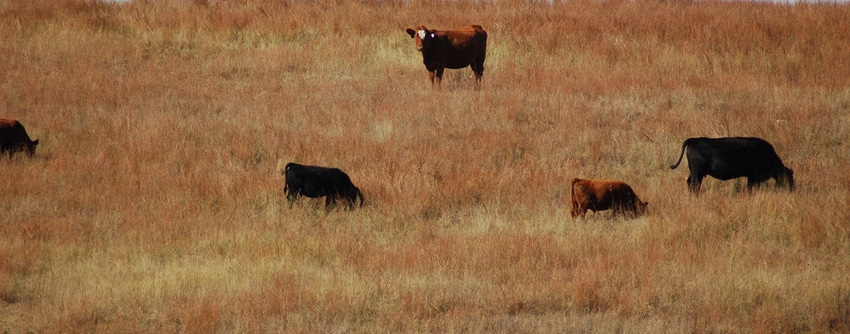
Shade can be a valuable resource for all cattle, but may be especially important for the predominantly black-coated genetics in this country, which springs from British and Continental European cattle never selected for heat tolerance.
Obviously, this has been shown extremely important in confinement situations like the feedlot, but appears to be quite valuable in pasture.
A quick review of research on pasture shade in Arkansas, Florida, Kentucky and Missouri showed these advantages:
Arkansas -- 20% higher gains for stocker cattle with shade than for those without.
Florida -- Cows with shade had conception rates of 44.4%, compared with 25.3% for cattle without shade.
Kentucky -- Animals with adequate shade gained at these rates over those without.
• Cows - 1.2 pounds per day
• Calves - 0.4 pounds per day
• Steers - 0.9 pounds per day
Missouri -- Cattle grazing endophyte-infected pastures with shade gained 0.7 pounds per day more than cattle without shade.
Three case studies in Missouri showed increases in performance for fairly nominal expenses. One study cleared three areas on the edges of timber into pasture, leaving trees spaced nicely for shade. Another established a black walnut orchard and rented the grazing under the trees for higher-than average price. Another thinned large areas of timber to create savannah, which is pasture with large numbers of trees, creating partial shade and partial sun.
In a 2006 review of shade research by Rory Lewandowski, Extension educator for Athens County, Ohio, Lewandowski analyzed the results of a 1970 Oklahoma State University study that found, over a four-year period, that steers grazing summer pasture gained 19 pounds more if they had access to shade than if they didn't.
The research suggested, however, this would depend on the actual amount of heat and humidity. If there were only 30 days when the temperature was 85ºF. or higher -- and when the temperature combined with humidity totaled 130 or more -- the gain advantage was only four pounds.
In years when the threshold of 130 was met or surpassed 50-60 days, the advantage in gain from available shad was 27-30 pounds versus no shade.
In 1970, the predominant breed of cattle was still Hereford, with a fair number of black-baldy and dairy-cross cattle mixed in. This suggests shade may be more important today that in the past, as the red coat color in British cattle has generally been shown to drive internal body temperature upward less than black coat color.
Shade problems are compounded by fescue, of course. Eldon Cole, livestock specialist for the University of Missouri, recently presented these results from southwest Missouri.
Two single-year studies of shade at University of Missouri's Southwest Research Center in Mt. Vernon suggest better values to previous studies mentioned earlier in this article.
In 2000 Cole tested a group of spring-calving cows, comparing some with access to portable manmade, metal-roof shade measuring 8 ft. x 12 ft. with no shade. The trial was done on both endophyte-infected and endophyte-free fescue.
In his comments, Cole did not mention that endophyte-free fescue, as a high-nitrogen, cool-season grass, can still leave cattle in a state of alkalosis, which aggravates heat stress.
He said the greatest difference showed up on the infected fescue where the shaded cows outgained the others by 0.72 pound per day for 84 days. The calves nursing the shaded cows also made slightly better gains, 0.17 lb. per day, but that was not significant. The trial ran from July 3 to September 25 and the animals were all black.
He added that the overall pregnancy rate was 87.5 percent for the cows given shade, versus only 50 percent for cows with no shade.
In 2001, the same trial was conducted at the Southwest Center using 550-pound steers. The shaded steers gained 0.2 pound more per day for 84 days than the unshaded ones. Like with the cows, when the comparison was made on the "hot" fescue pasture the difference increased up to 0.35 pound per day.
Cattle selection matters, too
In a blog for Beef Producer in July 2015, Jaime "Jim" Elizondo discussed the ability of some breeds, when selected properly, to be heat adapted regardless of coat color.
He says, "The Mashona breed of cattle are both black and red and were selected over hundreds of years under very hot, difficult conditions in Africa.
"About 70% are black and 30% are red. Due to them having an oily substance in and on their skin, they are able to reflect sunlight and remain comfortable regardless of color. I cannot tell there is any difference between the colors in their adaptation to Florida’s environment or in their heat tolerance."
Elizondo says it is quicker to blend in some adapted genetics than to start from scratch in unadapted cattle, but adds there is a way in either case to enact viable selection criteria.
"If you select for percentage of maturity attained at one year of age, along with correct hormone balance, meat-to-bone ratio and other attributes under non-pampered conditions, you will find the best animals."
Beef Producer has carried several articles in recent years from Elizondo and from African cattleman and consultant Johann Zietsman on ideas for breeding cattle adapted to intensive grazing and very-low-input ranching.
About the Author(s)
You May Also Like




